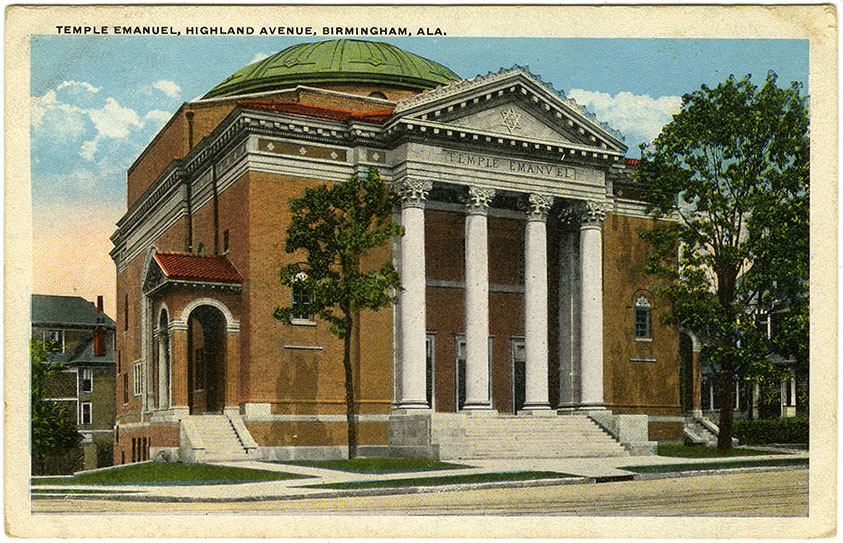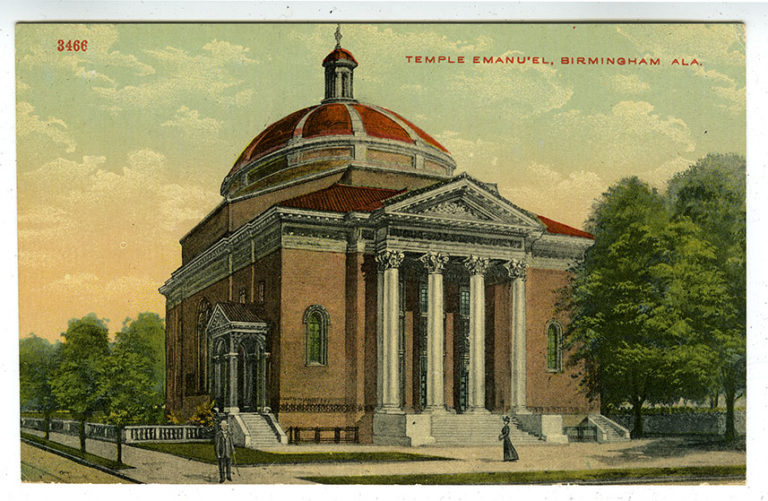7.2 Birmingham, Alabama
Temple Emanu-El, 2100 Highland Ave
William Weston, architect, 1914
Faulkner’s Novelty and Co., Birmingham, Alabama, publisher; no date; also on the back: “C. T. American Art”
The community that would become Temple Emanu-El (God is with us) first gathered in 1881. They met at the Cumberland Presbyterian Church for worship services. Land for the synagogue was purchased in 1884, and the congregation’s first building on 5th Avenue North at 17th Street was inaugurated on January 24, 1889. Stylistically, it was a mix of Romanesque, Gothic, and Moorish elements, with a corner tower and at least three turrets, all with bulbous cupolas. A large Magen David (Star of David) was proudly emblazoned on the facade gable.
Over the next two decades, members moved from the Northside neighborhood of Birmingham to the new residential area around Highland Avenue. They were following the wealthy Otto Marx, pioneering a prosperous new neighborhood, and also fleeing Northside, just when new Eastern European Jewish immigrants were settling there. In 1908, the congregation’s leaders purchased land at 21st and Highland, and a new synagogue was planned.

In 1895, Rabbi Morris Newfield began his 45-year tenure at Emanu-El, and under his leadership the congregation embodied the values and outlook of the recently formed Union of American Hebrew Congregations. Not surprisingly, the style chosen for the new temple was pure Roman classicism, Reform’s architectural preference in the early 20th century.
William Weston, a leading Birmingham architect who had trained with the great Daniel Burnham in Chicago, was hired to provide space and a grand setting for Emanu-El’s growing membership. Weston had designed the Brown-Marx Tower (1906), where Otto Marx’s company was a main tenant, and he also designed a new lavish house for Marx in 1909, just as planning for the synagogue began. Like his mentor Burnham, Weston designed modern office blocks and monumental architecture. He was working simultaneously on the 27-story City Federal building, which opened in 1913. For Emanu-El he designed a large domed synagogue, fronted by a portico of four massive columns. It recalls great classical and Renaissance buildings like the Pantheon and Palladio’s Villa Rotonda, but many synagogues of this type were already built across America.
The new building took longer to build than hoped, and the congregation celebrated High Holiday services at just-completed Southside Baptist Church. When dedicated in March 1914, the new synagogue was worth the wait. It was highly visible proof of Jewish prominence in Birmingham. But the temple was hardly unique. Southside Baptist and the Christian Science church, erected in 1911, were also built in the classical style.
Unlike many congregations that left their early 20th–century buildings—often moving to the suburbs in the decades after World War II—Temple Emanu-El has stayed put for more than a century. Temple Beth El, Birmingham’s Conservative congregation also located on Highland, made the same decision to maintain a strong Jewish presence in the city. In 2004, Emanu-El underwent an extensive renovation and expansion costing $17 million. The sanctuary was updated and restored, and the auxiliary buildings were entirely rebuilt for a variety of congregational and community functions.

